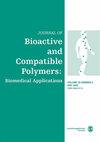Extracellular matrix coated three-dimensional-printed polycaprolactone scaffolds containing curcumin for cartilage tissue engineering applications
IF 2.1
4区 生物学
Q3 BIOTECHNOLOGY & APPLIED MICROBIOLOGY
引用次数: 0
Abstract
Extracellular matrix (ECM) is widely used for clinical purposes in tissue engineering (TE). Since ECM does not have favorable mechanical properties, its use has been limited. Therefore, it is helpful to use synthetic polymers such as polycaprolactone (PCL) to improve the mechanical properties of ECM-based scaffolds. PCL scaffolds were prepared via the three-dimensional (3D) printing method. Cartilaginous ECM was obtained from bovine femur, and then it was decellularized and solubilized. PCL scaffolds were functionalized using 1,6-hexanediamine; consequently, the scaffolds were coated with solubilized decellularized ECM (SDECM) using two types of crosslinkers; namely, N-(3-dimethylaminopropyl)-N-ethylcarbodiimide hydrochloride/N-hydroxysuccinimide (EDC/NHS) and genipin. Genipin-crosslinked SDECM-coated (PCL/ECM-Gen) scaffolds and EDC/NHS-crosslinked SDECM-coated (PCL/ECM-EN) scaffolds were characterized by different tests. Following loading the curcumin (Cur) on the scaffolds, the Cur release rate was investigated. Finally, human chondrocyte cells were cultured on the scaffolds to explore cell viability, cell attachment, and histological studies. Following functionalization via amine groups, 5% SDECM was used to coat the scaffolds, and this increased the wettability and cell viability of the PCL. Genipin crosslinked and coated the SDECM more efficiently compared to the EDC/NHS and led to lower porosity, water absorption capacity, degradation rate, higher cell proliferation, and cell attachment. Genipin-crosslinked Cur-loaded (PCL/ECM-Gen + Cur) scaffolds showed higher cell viability but lower antibacterial activity compared to EDC/NHS-crosslinked Cur-loaded (PCL/ECM-EN + Cur) scaffolds, which may indicate EDC/NHS-induced cytotoxicity. This study elucidates the value of PCL/ECM-Gen + Cur scaffolds as highly biocompatible scaffolds that can be considered a promising tool for cartilage TE applications.含有姜黄素的细胞外基质涂层三维打印聚己内酯支架在软骨组织工程中的应用
细胞外基质(ECM)被广泛用于组织工程(TE)的临床用途。由于细胞外基质不具备良好的机械性能,其使用受到了限制。因此,使用聚己内酯(PCL)等合成聚合物来改善基于 ECM 的支架的机械性能很有帮助。PCL 支架是通过三维(3D)打印方法制备的。软骨 ECM 取自牛股骨,然后对其进行脱细胞和增溶。使用 1,6-己二胺对 PCL 支架进行功能化,然后使用两种交联剂,即 N-(3-二甲基氨基丙基)-N-乙基碳二亚胺盐酸盐/N-羟基琥珀酰亚胺(EDC/NHS)和吉尼平,在支架上涂覆溶解的脱细胞 ECM(SDECM)。基因素交联的 SDECM 涂层(PCL/ECM-Gen)支架和 EDC/NHS 交联的 SDECM 涂层(PCL/ECM-EN)支架通过不同的测试进行表征。在支架上添加姜黄素(Cur)后,研究了姜黄素的释放率。最后,在支架上培养人软骨细胞,以探讨细胞活力、细胞附着和组织学研究。通过胺基团进行官能化后,5% 的 SDECM 被用来包覆支架,这增加了 PCL 的润湿性和细胞活力。与 EDC/NHS 相比,Genipin 能更有效地交联和包覆 SDECM,从而降低孔隙率、吸水能力、降解率、细胞增殖率和细胞附着率。与 EDC/NHS 交联的 Cur 负载(PCL/ECM-EN + Cur)支架相比,Genipin 交联的 Cur 负载(PCL/ECM-Gen + Cur)支架显示出更高的细胞活力,但抗菌活性较低,这可能表明 EDC/NHS 诱导了细胞毒性。这项研究阐明了 PCL/ECM-Gen + Cur 支架作为高生物相容性支架的价值,可被视为软骨 TE 应用的一种有前途的工具。
本文章由计算机程序翻译,如有差异,请以英文原文为准。
求助全文
约1分钟内获得全文
求助全文
来源期刊

Journal of Bioactive and Compatible Polymers
工程技术-材料科学:生物材料
CiteScore
3.50
自引率
0.00%
发文量
27
审稿时长
2 months
期刊介绍:
The use and importance of biomedical polymers, especially in pharmacology, is growing rapidly. The Journal of Bioactive and Compatible Polymers is a fully peer-reviewed scholarly journal that provides biomedical polymer scientists and researchers with new information on important advances in this field. Examples of specific areas of interest to the journal include: polymeric drugs and drug design; polymeric functionalization and structures related to biological activity or compatibility; natural polymer modification to achieve specific biological activity or compatibility; enzyme modelling by polymers; membranes for biological use; liposome stabilization and cell modeling. This journal is a member of the Committee on Publication Ethics (COPE).
 求助内容:
求助内容: 应助结果提醒方式:
应助结果提醒方式:


